Organize Your Hardware, Organize Your Shop
In this video, Ben Strano shows how he keeps his sizeable collection of hardware tamed and organized so that he can find what he needs when he needs it.
I like to keep my shop organized. Unfortunately, I can’t say that extends to the rest of my life. Woodworking is a retreat from day-to-day stresses for me, and if I come out to my shop and can’t find what I need, I’m adding more stress to my life. So if you’re like me and like to use woodworking as an escape, it may be time to buckle down and organize your shop a bit more so that it’s not stressful when you try to work. Whether your retreat is a basement shop that shares laundry duties, or a garage where cars get pulled in at night, these organizational principals can be used in any shop.
Purge
Let’s get the hard part out of the way. Everything in that coffee can labeled “screws”–you don’t need it. It sounds amazing to some, but the walls will not cave in on you if you throw away useless nuts and bolts. I promise you nothing happens. “But what if I need it one day?” The stress and clutter that collection of random hardware causes far outweighs the stress and expense of a visit to the hardware store. You can keep that collection of brass hardware your grandfather had stored away in a bin, but don’t be sentimental about 8mm stop-nuts.
Start big
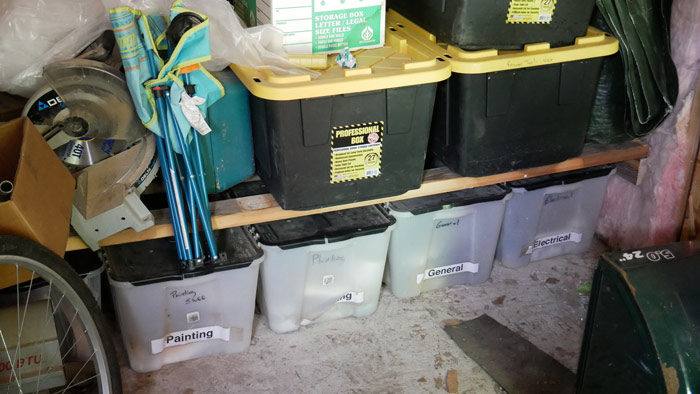
I’m lucky that I was able to wall off a bay of my shop to keep “garage stuff” out of the woodshop. My last shop was a shared space (basement, general storage, laundry) and I kept it somewhat organized by using large bins for very general organization of the things that I might use once a year. Plumbing fittings went into a plumbing bin, painting supplies into a painting bin. See the pattern? Don’t try and get micro-organized here. Just get the clutter out of sight.
I fix 98% of what’s broken around our house, and I like to have extras on hand. Even so, I’m able to fit just about all of my extra “stuff” into six bins, keeping the contents out of sight and out of mind. I prefer bins with attached lids; this way the top doesn’t get lost, making the whole thing useless.
Medium-size storage for bits and bobs
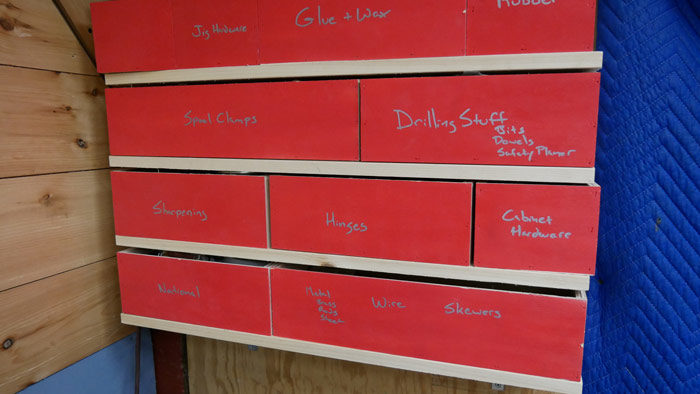
I have a storage wall for common woodworking items–hinges, brackets, extra glue, wax, and random bits of metal. This organization system was inspired by a video of Casey Neistat’s showing off how he organizes all the accessories that come with running a video studio. His system is based on a wall of red plastic toolboxes. Wanting to pay homage to Neistat, I made my red boxes out of wood and kicked them up a notch by making them in three different sizes, 6 in., 12 in, and 18 in. wide. This allows me to store longer items, and the boxes have a satisfying “Tetris” vibe. The most important aspect is that this wall system can grow and conform to what I need to organize since I could easily make more of them.
The little stuff is the most important part!
I’ve worked in hardware stores for about a quarter of my life–all through high school and college, and for a couple of years before I came to work at the magazine. I really enjoy hardware stores. Maybe a part of me just wants to have a mini-hardware store in my shop, and another part of me doesn’t like looking for things, and wants to have everything on hand when I need it. I buy most of my screws in bulk, which saves money in the long run. The rub is, if you’re going to have a large supply on hand, you’d better have a way of organizing them.
Seven years ago, Adam Savagestarted trend of hardware organization with his video (above). Adam’s system is centered around Sortimo bins, which are widely available in Europe, but here in North America they run in excess of $60 apiece. Adam’s Sortimo bins allow him to organize cases with various sized cups within them, making them adaptable to just about any set of hardware.
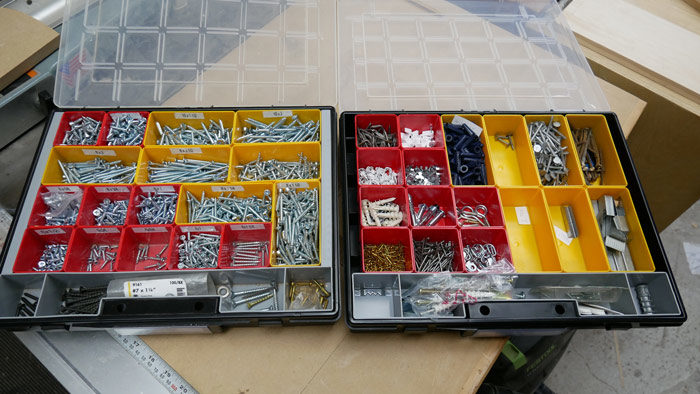
I have built my organization around a much more affordable version, while still checking all of the boxes the Sortimo cases do. Coming in at $21.50 apiece from Lee Valley, the Allit economy storage bins have proven to be well worth the outlay. There are more affordable versions made by Stanley and Harbor Freight, but for me, these are the perfect balance between quality and affordability. Extra cups are available for about a dollar apiece. I started with two bins, to see how things fit, followed by four more bins, 15 1×1 red cups, and 10 2×1 yellow cups. I’ve been able to organize almost all of my hardware with those six bins.
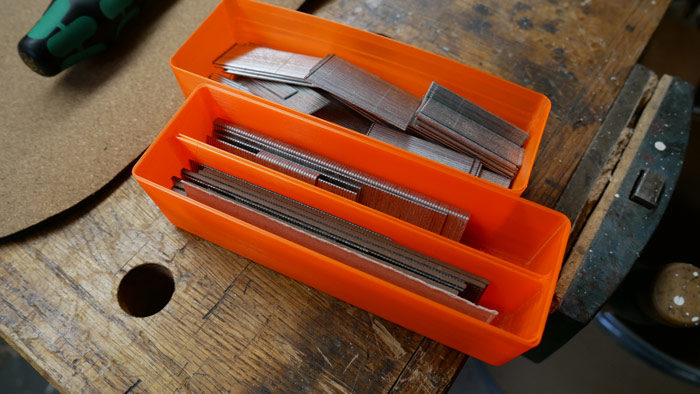
If you have a 3D printer you can print up more cups. I wouldn’t recommend printing all of your storage cups like Alexandre Chappel did in this incredible video–they really take a long time to print, and it’s unlikely you’d save any money. I wound up printing a few cups that weren’t available, like a 3X1 for a pneumatic nails (and this one with a divider).
Allow your storage to grow
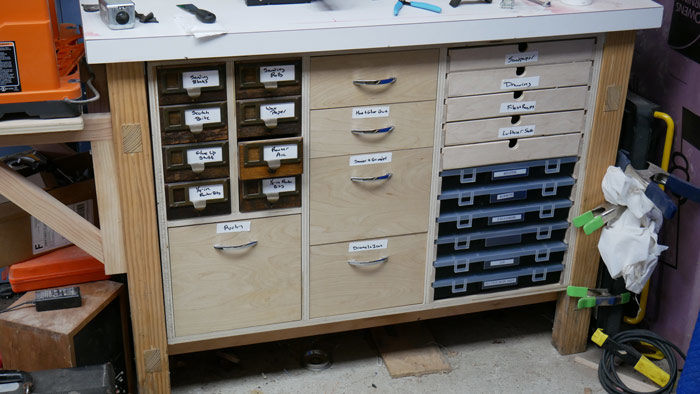
Think of your storage system as a living thing. Your organization needs to be able to grow. If it can’t, you’ll eventually work yourself into a corner, overflow, and you won’t be organized anymore. I try to make sure that all of my systems work together, and can grow so that I can stay organized years from now.
The more organized you keep your shop, the more enjoyable you’re going to find your shop time, and isn’t that the whole point of having a wood shop? It actually starts to become fun and addictive to see how efficient you can make things.
 |
|
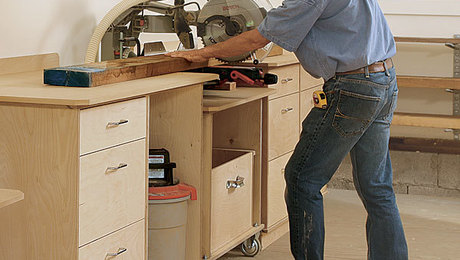 |
|
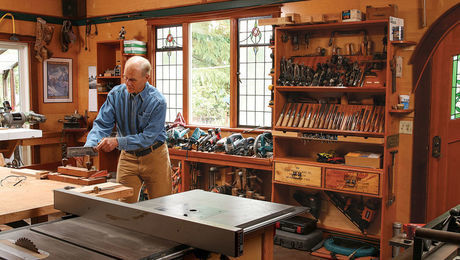 |








Comments
Good advice, Ben. One note: Community recycling centers often have a place to dump unwanted metal, including nuts and bolts that need to go.
Great little video Ben
Have you ever played "pairs" - a card game in which you lay out the pack face down then take tuns turning over two of them trying to remeber which are the aces, twos, threes, etc.? I've found that my extensive collection of wotnots and fangleparts - even though placed in various containers and locations - gradually get easier to find as you play "pairs" with them over the years.
I have recently re-organised my extensive collection of pure furniture hardware: the hinges, knobs, catches et al (rather than the ten thousand screws and fittings of more general utility). I even practiced making various designs of small boxes to re-organise those several and various hinge & knob.
Of course, now I have to play "pairs" with them all over again, as their old and well-remembered placements are no more........
***
As to throwing away that doodwat you've had for 25 years - madness!. Only last week I rooted out a bolt-bearing-bit that had been in a box deep within the horde of such stuff, with which to mend a very large umbrella canopy that poinged a similar bolt into the garden shrubbery to be never-more-seen except by the beetles and worms. Think-on before you cast away those soon-to-be-indispensable bits!
Lataxe
Just sent a bunch of stuff to the local Habitat for Humanity Restore. The rolls of drywall tape, the tiling trowel that I'll never use again, boxes of old hinges and door knobs, and the 4 unused snap lines that were wandering around in different bins. They sell it and use the money to build new homes for under privileged families.
My other key to shop organization is to keep the accessories next to the big tool they work with. Router bits store under the router table, drill bits store under the drill press.
The other big key to shop organization that Ben did not address is storing scraps of lumber. That last little bit of Cypress or Teak that I might need for another project. Those random cuts of oak left over from the table I made, etc. They are hard to throw away, and take up much more space than the screws.
Next to my cabinet you'll see a pile of random stuff waiting on our Habitat store to reopen. It's a wonderful place. I do have a problem dropping stuff off and then almost rebuying it next time I'm there.
I appreciated your comment about throwing away 8mm nuts you'll never use again because you haven't used them for a year or two. However, I find that with tools, you have to have a longer horizon. For a long time, I had a 20 year rule on tools. If I haven't used that split-ring pliers for 20 years, well, it's a candidate to go. More recently, I've drifted toward a 10-year horizon as things have started to pile up a bit after 35 years in one place.
Loved the video, Ben. One question: at 12 minutes in, you hold up a gray box and lament that it won't hold a 3" screw. Can you clip out the plastic divider to make it fit? Would that be heresy? And, yes, I think the removable plastic bins are better, but at what cost? Keep up the good fight against entropy, but remember that entropy always wins in the end!
I did that on one box. The was no good way of doing it cleanly, it looked like garbage and it bothered me. I have some issues... I know it. Oh, and to answer your "At what cost" question, $21.50 a bin!
Very good, Ben.
When I was young my father worked for a battery manufacturer. At one point they changed the appearance of their branding and had a lot of unusable metal cans for 12-volt lantern batteries they were going to dispose of. My dad must have brought home about 4 dozen of them and turned them into storage bins for hardware and other goodies that collect in a shop. Thy worked extremely well. I kind of wish I'd kept them after he died. Not only for the nostalgia but for the usefulness.
Thanks Ben. I try and keep my shop organized. I really like Christian Becksvoort's system in using an old card catalog. I recently bought his last book that contains some "drawings". In there is a 4 footish tall cabinet that has lots of drawers. I am going to build one of those this year to put lots of little things in. I am also a huge fan of peg board. I used 1x2's secured into the studs and then put the pegboard onto this. I bought lots of different size things that work in the pegs. That way, if I want to hand something, I can find some sort of hook or box that will work. Now, you have convinced me to recycle the cardboard boxes that my LieNielsen tools came in. I'm not going to sell the tools and to be honest, the boxes take up more space than I would like.
The other thing I have done in the garage is I had a company come in that install ceiling mounted wire rack systems. A 4x8 size ran something like $300 or $600 installed. It increased a lot of storage space for things that we need to keep but are infrequently accessed.
Post comment update: Hi Ben, I went out to the garage and cut up all the boxes. Though I keep my woodworking bench clean, all those boxes were on one of those collapisable tables. After cutting up the boxes, I spent like 20 minutes cleaning up the rest of the table. Dude, you rock! In 20 minutes the table went from a mess to sparkly clean. For the last two years it looked messy and all it took was 20 minutes! Thank you.
I do have a mess of screws and such to toss. Do you happen to have a good source to get variety packs of screws, nuts & bolts, and nails? I ordered those Lee Valley storage containers and a few for my daughter to put her little toy figures (think small my little ponys) in. Thanks for that tip. If you know of good sources for variety packs you would be helping many of us.
For storing hardware, check out these two organizers from Stanley:
https://www.stanleytools.com/products/tool-storage/tool-organizers/professional-organizer/014725r
https://www.stanleytools.com/products/tool-storage/tool-organizers/deep-professional-organizer/014710r
The deep one has two different cup sizes, while the shallow one has three different cup sizes. I have a bunch of these for fasteners and electronic components.
Harbor Freight has knockoffs of these organizers, but the Stanley ones are much better quality.
Great video, Ben. I'm also a little ocd about shop organization. My hardest throw-out, as someone mentioned above, is scrap wood. In winter I burn it when it overtakes my shop, but in S GA fire season is about like summer in Maine----very short! Love the Allit bins. Had not seen those. Great August issue under trying circumstances, I'm sure.
Robin Wise
Nice video, I really like the suggestion on start big. I will be putting my plumbing, engine, and electrical stuff into bins this week and moving them over to the storage shelf area of my basement. Not sure if I will be able to purge grandpa's bolts and screws.
Super video Ben! I am somewhere between your dad's collection and yours in terms of organization. You are correct about the ease and enjoyment of wood working if it is more organized. I also use the Allit bins and they work really well; I use them for general storage, for specific project hardware and if I am cleaning/fixing/restoring something with some disassembly required, parts go in an Allit bin until I am finished.
It only takes one move when you've collected a pile of stuff over years to make you appreciate reorganizing. It took one mover a whole day to pack the contents of my previous 60 square foot shop, and that was after I had sold or otherwise distributed the first layer of excess. (who needs 4 braces, really?)
I am now approaching the stage of life where someone is going to have to go through my "dragon's pile" so the more organized it is, the less pain someone else will have.
This was not only informative, but also inspirational Ben, thanks!
Now I need to find the coffee can(s) of old hardware so that I can liberate myself (and my shop) of hardware that hasn't seen the light of day in far too long.
This is great Ben. You gave me some great ideas/inspiration. I've been converting my shed/workshop into a workshop. I don't have a garage, but I recently got one of those metal sheds to store non-woodworking tools and that box of plumbing crap I just want to keep around. The metal shed is basically a toolbox for smaller toolboxes - nesting toolboxes.
Thanks Ben! I have been fighting for my basement woodshop since we moved into our retirement foreclosure 5 years ago. Each year brings me a little closer to my goal of an organized working shop. A bit of advice... a wood storage bin is a critical component. Mine has 4 levels, but I made the mistake of designing it with access only from the narrow end - bad idea. Building floating shelves is more difficult but infinitely more accessible. My next project: a storage rack on rollers for sheets of plywood. Roll it out of the way then over to the table saw or workbench for dissection.
Many of my organization ideas come from FW. Some are found only when microscopically studying pix of the pro shop tours you do so often. I look in the background and imagine whether what I see would be useful to me. For instance: your guitar jig. It tells as much about what you do as the good organization, but I am not an instrument maker.
Cheers!
Another GREAT instructional video, Thank You. In your last comments I saw in the back ground, a miter gauge with a attachment for a fence of wood. Can you please let us know where this might be found. Thank You
Lots of good ideas, thanks.
I borrowed a technique from the pantry where my wife hangs all the pots, pans and kitchen tools from pegboard.
You can see everything, rearrange as needed and in earthquake country it's more secure than shelves.
I like the colored stacking plastic bins from Uline. They come in a range of sizes. Also, Talenti ice cream containers are a perfect size in clear plastic if you like ice cream and organization.
Aloha Ben - great video...loved the Allit bins/drawer combo and might steal that from you. I recently added the 'large bin' grouping (like your plumbing box) and it really helped.
Best part of your vid - your Dad's garage. Just. Like. Mine.
In my career, organization was a survival mechanism; without it, daily failure was almost assured. This spilled over into my shop BUT, I had the annoying cardboard boxes, bags, large metal shelves, etc. of "Big Stuff". Big stuff is not always large in and of itself but, it takes up large chunks of otherwise useful space.
Just as in your "Start Big" section, I used large plastic storage bins. I labeled them brutally like "Plumbing Stuff", "Paint Stuff", "Electrical Stuff". I have more refined storage methods for things in all these categories that I actually use on a regular basis. However, the random "stuff" in these categories has now been tamed.
The big bins are for that stuff . . . you knows the stuff . . . an old bathroom faucet, paint rollers, switch-plate covers that are the wrong color but, brand new, 7 feet of 6 gauge wire, sash brushes that have house paint residue on them, etc., etc.. By making a gross categorization of "That Stuff" and grouping it into large bins out in a shed or outbuilding I freed up large chunks of space. I can still easily get to the "stuff" but, now it is out of my shop!
Really enjoyed the video, Ben!
You mentioned some lesser expensive (to the Allit) boxes, but I didn't see a link or brand mentioned. Can you please elaborate, for us retired guys?
Good stuff Ben. Here is storage bin that I got from Home Depot.
https://www.milwaukeetool.com/Products/Storage-Solutions/Plastic-Storage/Organizers/48-22-8030#sp-specs
Very nice video, Ben. When my father, from whom I inherited the dominant packrat gene, passed away, I inherited much of the crap from his shop / wonderland. Now, I can wander through my own shop and experience much of the same wonder and surprise you describe while visiting your dad's shop. (Only recently, I discovered what a saw set is, what they look like, and that I own a really cool old one.) Anyway, my biggest storage challenge has been to store, or hide, the millions of powered hand tools I have either bought, found, or inherited. They all have cool cases, with premolded storage for bits, blades, and attachments I'll never use. I'm thinking of building a timber frame outbuilding just to store extra drills, routers, and biscuit joiners. Perhaps you, as an internet influencer, could induce the manufacturers to print a one word title on the case, e.g., "DeWalt, laminate trimmer."
Great ideas Ben, I'm interested in building a cabinet like your right side with the interchangeable drawers and parts cases. Might you have plans and dimensions? From the video looks like 3/4" plywood sides with 3/8" or a 1/2" supports on either side. Do the cases have the strength and durability to suspend them from the lid, or would a 1/4" shelf underneath be better?Any info would be helpful,
Thanks so much for some great organizational ideas! Time to eliminate all those glass bottles and take advantage of the wasted shelf space. :)
Great video, Ben! I like your presentation style...
Couple of comments: as an old woodworker and carpenter - more like your family tree predecessors than you - I have to disagree somewhat on what/when to toss stuff, but generally agree that paring down the collection (don’t like the term ‘purge’) is a good idea...
And I saw you throwing perfectly good hardware into the TRASH instead of the RECYLE BIN...!!! Mother Earth is disappointed.
Great video sir, you have a great conversational tone. In my own workshop I embraced the organization of the fishing world since the Plano boxes were only $7 and easier to find than the nice euro ones. I mixed in a few large boxes and the dividers inside let you put those 3-inch screws with the 1/2-inch ones. They also have some deeper versions for bigger tools or bolts.
Great Video, Great ideas. We all need these tips.
Thanks for this video Ben, I totally agree with your passion for organization. Another factor is that a clean and well organized shop is safer. The room is not filled with scattered objects to knock onto the floor, step on, trip over and bash carefully made parts into while moving about. I also find that I need to start each phase of a project with my workspace clean and tidy. If it’s a mess and disorganized my project is at risk of being a mess and disorganized. My shop is also quite small, I don’t want anything in there that is not part of woodworking or is never used. Excess stuff soon fills up space that I need for tools, supplies and of course to work in
I started out with the Akro-Mils cabinets and still have a wall of them about 6' long and 4' high. For larger things I use the shoebox sized plastic storage containers from the box store (I have about 100 of these). Over the last few years I've been migrating the smaller parts to plastic containers from Global Industrial, both the large and small sizes. the larger ones are about $10 each with shipping. I have about 40 of the large and 20 of the small size. the Akro-Mils cabinets are a PITA to move as the tops are not closed. As for removing unwanted dividers I tried many things and found that my end and side cutters from FastCap make quick work of removing them.
Ben, we all know perfectly well that fter you throw away that coffee can full of hardware you've been hording for 30 years, the very next day you will need exactly what was in that can!
Log in or create an account to post a comment.
Sign up Log in